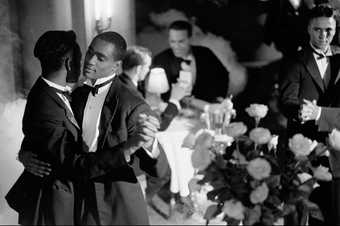Isaac Julien’s film Looking for Langston breaks down traditional divisions between different art forms
The work explores Black, queer desire in a setting which has no clear time or place. It brings together poetry and image to look at the private world of the Black artists and writers who were part of the Harlem Renaissance in the 1920s. The film begins with a recording of a radio broadcast made in tribute to US poet and social activist Langston Hughes after his death in 1967. A cast of mourners gathers at an imagined version of Hughes’s funeral, with Julien playing the part of the deceased poet in his coffin. The camera moves to a bar scene, set somewhere between a 1920s speakeasy and a 1980s nightclub. Men in black tie gather and tenderly partner up to dance or sit with a drink or cigarette.
The film continues to shift, from imagined scenes and dream sequences to archive footage, tracing the relationship between a younger Hughes and Beauty, the object of his desire. The soundtrack mixes archive recordings of the poetry of Hughes (1901–1967), Richard Bruce Nugent (1906–1987), James Baldwin (1924–1987) and Essex Hemphill (1957–1995) alongside 1980s club music. The film ends with a raid on the bar by a mob of police and thugs with shaven heads, leather jackets and heavy boots. Looking for Langston addresses the daily dangers faced by queer people of colour.
Though the film is not set in any particular time or place, it was made at the height of the AIDS pandemic in the 1980s. Today, it still retains a sense of urgency and relevance.
Curated by Aïcha Mehrez
Tate Britain

